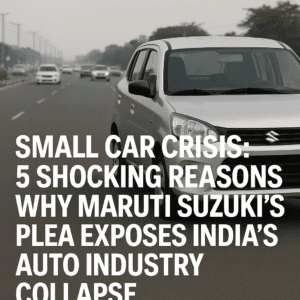Small Car Crisis: 5 Shocking Reasons Why Maruti Suzuki’s Plea Exposes India’s Auto Industry Collapse
Maruti Suzuki urgently requests government incentives to revive India’s collapsing small car segment, where sales have catastrophically declined. Once dominant, entry-level models (sub-₹5 lakh) plummeted from 934,538 units (FY16) to just 25,402 (FY25), with May 2025 sales of Alto/S-Presso slumping 32% YoY. Stricter safety/emission regulations have drastically raised prices, blocking millions of two-wheeler owners from affordable car ownership.
This threatens inclusive mobility and industry growth, as small cars now represent under 28% of the market versus 47% in FY18. While Maruti diversifies into robust exports (targeting 400k units in FY26) and eyes EV expansion, domestic pressure persists—evident in its recent profit dip. The appeal underscores a critical crossroads: without policy intervention, India risks losing its gateway to four-wheeler ownership for aspirational households, reshaping the auto landscape irreversibly.

Small Car Crisis: 5 Shocking Reasons Why Maruti Suzuki’s Plea Exposes India’s Auto Industry Collapse
Maruti Suzuki, India’s automotive giant synonymous with affordable mobility, has issued a stark warning: the iconic small car segment, once the engine of the nation’s passenger vehicle market, is on life support. Their urgent call for government intervention isn’t just corporate lobbying; it reveals a critical juncture for India’s car industry and millions of aspiring buyers.
The Vanishing Entry Point: Data Tells the Story
The decline isn’t a blip; it’s a structural shift with alarming numbers:
- Market Share Collapse: Small cars (hatchbacks and compact sedans priced under ~₹5 lakh) dominated nearly half the market (47.4%) just seven years ago (FY18). Today, they cling to barely 27.7% (FY24).
- Sales Freefall: Entry-level models (like Maruti’s Alto, S-Presso) tell the grimmest tale. Sales plummeted from nearly 1 million units (934,538) in FY16 to a mere 25,402 units in FY25 – a near wipeout.
- May Misery: May 2025 sales underscore the trend:
- Alto/S-Presso: 6,776 units (vs. 9,902 in May 2024)
- Compact Cars (Baleno, Swift, WagonR, etc.): 61,502 units (vs. 68,206 in May 2024)
Why the Wheels are Coming Off:
Maruti Suzuki’s Partho Banerjee (Senior Executive Officer, Marketing & Sales) pinpointed the core issue: crushing affordability.
- Regulatory Burden: Stricter safety norms (like mandatory airbags, ABS) and emission standards (BS6 Phase 2, RDE, CAFE 2) significantly increased production costs. These essential upgrades disproportionately impact the ultra-price-sensitive entry-level segment.
- The Two-Wheeler Gap: The dream of upgrading from a motorcycle or scooter to an affordable car is fading. “Enhanced regulation… prices… have increased significantly, impacting buyers who want to upgrade from two-wheelers,” stated Banerjee. The price jump from a ₹1 lakh scooter to a ₹5+ lakh car has become a chasm too wide for many.
- Shifting Consumer Preferences: Rising incomes and easier financing have fueled demand for feature-rich SUVs and larger vehicles, further squeezing small car appeal. Dealers confirm that even budget-conscious buyers now stretch for compact SUVs over basic hatchbacks.
The Ripple Effect: Beyond Maruti’s Bottom Line
This isn’t just a Maruti problem:
- Stalled Industry Growth: Small cars were the primary volume driver. Their decline inherently caps the market’s overall expansion potential.
- Socioeconomic Impact: Affordable cars enable safer, more comfortable, and weather-protected mobility for millions of families. Their disappearance leaves a significant gap in accessible personal transport.
- Manufacturing Focus: If the segment dies, automakers will inevitably shift resources further towards premium segments, potentially reducing India’s strength as a global small car hub.
Maruti’s Lifeline Request & Silver Linings
Banerjee’s appeal is direct: “Some incentives are required so that the customer who is not able to afford the car can come in.” While specifics weren’t outlined, possibilities include:
- Temporary GST reduction for sub-4m cars below a certain price point.
- Targeted scrappage policy benefits for two-wheeler owners upgrading to small cars.
- Government-backed financing schemes for first-time entry-level buyers.
Meanwhile, Maruti diversifies:
- Export Surge: Targeting 4 lakh exports in FY26 (20% growth), leveraging markets in Africa, LatAm, SE Asia, and surprisingly, Japan (driven by Fronx & Jimny). Exports now make up a crucial 43% of India’s total vehicle exports.
- EV Pipeline: Anticipates further export growth with upcoming EV models.
- Q4 Reality Check: While Q4 FY25 revenue grew 6.4% to ₹40,674 crore, profit fell 4.3% to ₹3,711 crore, reflecting domestic volume pressure despite export strength.
The Road Ahead: A Critical Crossroads
Maruti Suzuki’s plea highlights a fundamental truth: India’s auto growth story cannot sustainably run only on premium and SUV segments. The health of the entry-level market is vital for inclusive mobility and long-term industry volume.
Whether the government heeds this call for targeted incentives will determine if the small car – the vehicle that put India on wheels – gets a fighting chance, or becomes a relic. The decision will shape not just Maruti’s future, but the accessibility of car ownership for a vast segment of the Indian population poised at the edge of mobility transition. The affordability crisis is real, and its resolution requires more than just automaker strategy.
You must be logged in to post a comment.